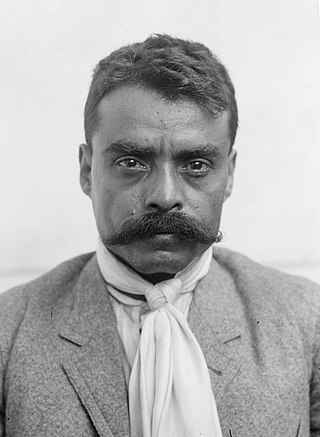
Emiliano Zapata Salazar was a Mexican revolutionary. He was a leading figure in the Mexican Revolution of 1910–1920, the main leader of the people's revolution in the Mexican state of Morelos, and the inspiration of the agrarian movement called Zapatismo.

The Zapatista Army of National Liberation, often referred to as the Zapatistas, is a far-left political and militant group that controls a substantial amount of territory in Chiapas, the southernmost state of Mexico.
Zapata usually refers to Emiliano Zapata, a Mexican revolutionary. It may also refer to:

Samuel Ruiz García was a Mexican Catholic prelate who served as bishop of the Diocese of San Cristóbal de las Casas, Chiapas, from 1959 until 1999. Ruiz is best known for his role as mediator during the conflict between the Zapatista Army of National Liberation (EZLN) and the Institutional Revolutionary Party (PRI), a Mexican political party which had held power for over seventy years, and whose policies were often disadvantageous to the indigenous populations of Chiapas. Inspired by Liberation Theology, which swept through the Catholic Church in Latin America after the 1960s, Ruiz's diocese helped some hundreds of thousands of indigenous Maya people in Chiapas who were among Mexico's poorest marginalized communities.

The Plan of Ayala was a document drafted by revolutionary leader Emiliano Zapata during the Mexican Revolution. In it, Zapata denounced President Francisco Madero for his perceived betrayal of the revolutionary ideals embodied in Madero's Plan de San Luis Potosí, and set out his vision of land reform. The Plan was first proclaimed on November 28, 1911 in the town of Ayala, Morelos, and was later amended on June 19, 1914. The Plan of Ayala was a key document during the revolution and influenced land reform in Mexico during the 1920s and 1930s. It was the fundamental text of the Zapatistas.

The Liberation Army of the South was a guerrilla force led for most of its existence by Emiliano Zapata that took part in the Mexican Revolution from 1911 to 1920. During that time, the Zapatistas fought against the national governments of Porfirio Díaz, Francisco Madero, Victoriano Huerta, and Venustiano Carranza. Their goal was rural land reform, specifically reclaiming communal lands stolen by hacendados in the period before the revolution. Although rarely active outside their base in Morelos, they allied with Pancho Villa to support the Conventionists against the Carrancistas. After Villa's defeat, the Zapatistas remained in open rebellion. It was only after Zapata's 1919 assassination and the overthrow of the Carranza government that Zapata's successor, Gildardo Magaña, negotiated peace with President Álvaro Obregón.

Genovevo de la O was an important figure in the Mexican Revolution in Morelos.

"People of the Sun" is the second single by American rock band Rage Against the Machine for their 1996 album Evil Empire. Written in 1992, the song is about the Zapatista revolution. Lead vocalist Zack de la Rocha wrote the song after a visit to Chiapas in southern Mexico. "People of the Sun" also has a music video. It was nominated for a Best Hard Rock Performance Grammy in 1998, but it lost to The Smashing Pumpkins' "The End Is the Beginning Is the End".
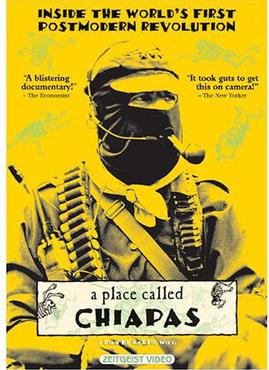
A Place Called Chiapas is a 1998 Canadian documentary film of first-hand accounts of the Ejército Zapatista de Liberación Nacional (EZLN) the and the lives of its soldiers and the people for whom they fight. Director Nettie Wild takes the viewer to rebel territory in the southeastern Mexican state of Chiapas, where the EZLN live and evade the Mexican Army.
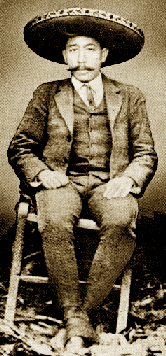
Manuel Palafox was a Mexican politician, soldier and intellectual.

Neozapatismo or neozapatism is the political philosophy and practice devised and employed by the Zapatista Army of National Liberation, who have governed a number of communities in Chiapas, Mexico since the beginning of the Chiapas conflict. According to its adherents, it is not an ideology: "Zapatismo is not a new political ideology or a rehash of old ideologies. .. There are no universal recipes, lines, strategies, tactics, laws, rules or slogans. There is only a desire: to build a better world, that is, a new world."
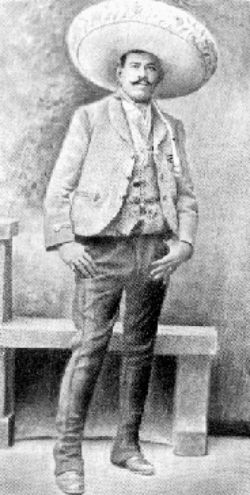
Amador Salazar Jiménez was a Mexican military leader who participated in the Mexican Revolution.
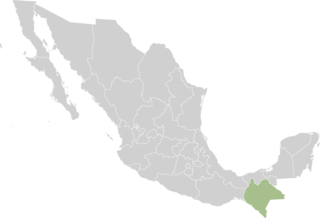
The Chiapas conflict comprises the 1994 Zapatista uprising, the 1995 Zapatista crisis and ensuing tension between the Mexican state and the indigenous peoples and subsistence farmers of Chiapas from the 1990s to the present day.

Rafael Sebastián Guillén Vicente is a Mexican insurgent, the former military leader and spokesman for the Zapatista Army of National Liberation (EZLN) in the ongoing Chiapas conflict, and an anti-capitalist and anti-neoliberal globalization icon. Widely known by his initial nom de guerreSubcomandante Insurgente Marcos, he has subsequently employed several other pseudonyms: he called himself Delegate Zero during the Other Campaign (2006–2007), and since May 2014 has gone by the name Subcomandante Insurgente Galeano, which he adopted in honor of his fallen comrade Jose Luis Solis Lopez, his nom de guerre being Galeano, aka "Teacher Galeano". Marcos bears the title and rank of Subcomandante, as opposed to Comandante, because, he is subordinate to, and under the command of, the indigenous commanders who constitute the EZLN's Clandestine Revolutionary Indigenous Committee's General Command.

The Battle of Cuautla was a battle between the forces of Emiliano Zapata and the federal army of the Mexican government that took place in the state of Morelos from May 11–19, 1911, during the Mexican Revolution. It has sometimes been described as "six of the most terrible days of battle in the whole Revolution". Eventually, the remains of the defending "Golden Fifth" regiment, the Fifth Cavalry Regiment of the Federal Army, withdrew and Zapata took control of the town. The Zapatista victory convinced Porfirio Díaz to come to terms with Francisco Madero, agree to the Treaty of Ciudad Juárez and resign as president.

Pablo González Garza was a Mexican General during the Mexican Revolution. He is considered to be the main organizer of the assassination of Emiliano Zapata.

Rebel Zapatista Autonomous Municipalities are de facto autonomous territories controlled by the neo-Zapatista support bases in the Mexican state of Chiapas, founded following the Zapatista uprising which took place in 1994 and is part of the wider Chiapas conflict. Despite attempts at negotiation with the Mexican government which resulted in the San Andrés Accords in 1996, the region's autonomy remains unrecognized by it.

Zapatismo is the armed movement identified with the ideas of Emiliano Zapata, leader of the Mexican Revolution, reflected mainly in the Plan of Ayala term 1911. The members of the Liberation Army of the South led by Zapata were known as "Zapatistas".

During the Mexican Revolution, from roughly around 1913 to 1917, the peasants from the Mexican region of Morelos established a territory with an alternative political, and economic system. They were heavily influenced by Emiliano Zapata and his ideology of zapatism. The political and economic structure of the territory was militarily supported by the Liberation Army of the South, which was where the army was formed. The commune is also at times compared to the Makhnovshchina in eastern Ukraine, due to their shared structures and ideals.
Florinda Lazos León was a Mexican revolutionary, journalist, politician and suffragist.













